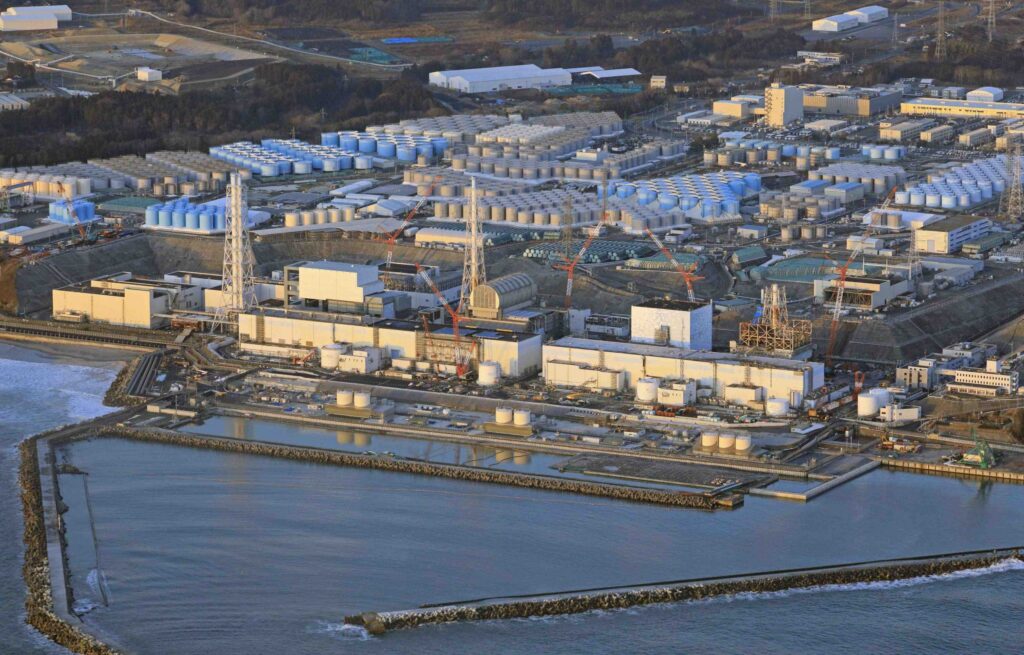❈ ❈ ❈
Unclear if Fukushima Cleanup Can Finish by 2051: IAEA
Courtesy: The Hindu
Too little is known about melted fuel inside damaged reactors at the wrecked Fukushima nuclear power plant, even a decade after the disaster, to be able to tell if its decommissioning can be finished by 2051 as planned, a U.N. nuclear agency official said Friday, August 27, 2021.
“Honestly speaking, I don’t know, and I don’t know if anybody knows,” said Christophe Xerri, head of an International Atomic Energy Agency team reviewing progress in the plant’s cleanup.
He urged Japan to speed up studies of the reactors to achieve a better long-term understanding of the decommissioning process.
A massive earthquake and a tsunami in March 2011 destroyed cooling systems at the Fukushima plant in northeastern Japan, triggering meltdowns in three reactors in the worst nuclear disaster since the 1986 Chernobyl accident. Japanese government and utility officials say they hope to finish its decommissioning within 30 years, though some experts say that’s overly optimistic, even if a full decommissioning is possible at all.
The biggest challenge is removing and managing highly radioactive fuel debris from the three damaged reactors, said Xerri, the director of IAEA’s Division of Nuclear Fuel Cycle and Waste Technology.
“We need to gather more information on the fuel debris and more experience on the retrieval of the fuel debris to know if the plan can be completed as expected in the next 30 years,” he told reporters.
The cleanup plan depends on how the melted fuel needs to be handled for long-term storage and management, he said.
Fifth review
The IAEA team’s review, the fifth since the disaster, was mostly conducted online due to the coronavirus pandemic. Only Xerri and another team member visited the plant this week before compiling and submitting a report to Japan’s government on Friday.
In the report, the team noted progress in a number of areas since its last review in 2018, including the removal of spent fuel from a storage pool at one of the damaged reactors, as well as a decision to start discharging massive amounts of treated but still radioactive water stored at the plant into the ocean in 2023.
Although there now is a better understanding of the melted fuel inside the reactors, details are still lacking and further research should be expedited, the report said. The team encouraged Japan to allocate sufficient resources to prepare for measures beyond the next decade through the end of the decommissioning.
Research and development of new technologies needed for the cleanup will take one or two decades, Xerri said, urging Japan to apply additional resources as early as possible.
The report advised Japan to prepare full plans not only for the cleanup of the melted reactors but also for the entire decommissioning, and a clearer end-state picture.
“It is important in any projects to have targets and to have objectives and to have a vision,” Xerri said.
Government officials and the plant operator, Tokyo Electric Power Company Holdings, have not provided a clear picture of how the plant will look when the cleanup ends.
In April, Japan announced it will start releasing into the sea large amounts of treated but still radioactive water that has accumulated at the plant since the accident. TEPCO on Wednesday announced a plan to release the water offshore via an underground tunnel after further treating it to reduce radioactive materials to allowable levels.
IAEA has agreed to help facilitate the decommissioning and cooperate in the monitoring and implementation of the water disposal. A first IAEA mission on the water disposal is expected to visit Japan in September.
❈ ❈ ❈
Fukushima’s Lasting Tragedy
In 2011 the Great East Japan Earthquake and ensuing tsunami devastated northeast Japan, taking the lives of more than 18,000 people and triggering one of the worst industrial accidents in history: the crippling breakdown of the Fukushima Dai’ichi nuclear power plant. Three of the plant’s six reactors suffered perilous nuclear core meltdowns and hydrogen gas explosions, releasing radionuclides into the air, water and soil. More than 160,000 people were evacuated–nuclear power refugees, many of whom have lost trust in their government’s pronouncements about “safe to return.”
Five Years Later
Considered the most complex industrial cleanup, not even robots were able to enter the main radioactive fuel-debris areas by 2016. The regional farming and the fishing industries suffered collapse and financial ruin. Permissible levels of radiation for children were raised in a callous move to keep schools open. Debates over canceling the 2020 Tokyo Olympics ensued because of the geographic spread of radioactive pollution–an issue all but forgotten as more recent debates rose over canceling the subsequent 2021 Olympics because of Covid-19 and Japan’s low vaccination rate.
Three hundred tons per day of groundwater containing large amounts of radioactive material, including cesium, strontium, iodine, and other substances, poured into the Pacific Ocean from 2010 until the Tokyo Electric Power Company (TEPCO), the plant’s owner, decreased it to one-tenth that volume by 2015. On site over 1,000 mammoth storage tanks hold wastewater treated by a filter process TEPCO devised to remove more than 60 radioactive chemicals to so-called safe internationally regulated levels. Only the treatment has left 70% of the filtered wastewater still contaminated above regulatory levels. Nor can it remove tritium, a radioactive form of hydrogen.
In September 2015, ocean surges from Typhoon Etau overwhelmed the site’s drainage pumps; hundreds of tons of radioactive water leaked from the reactors site and ultimately into the ocean. What, then, of more severe typhoons, undersea earthquakes, and the reality of sea level rise for the oceanside plant? How will an onsite drainage system survive natural disasters worsened by climate change if they failed in 2015?
Now
On April 13, 2021, the Japanese government announced that TEPCO has the government’s permission to release 1.38 million US tons of its filtered radioactive wastewater into the Pacific Ocean, beginning in 2023. The company states that its storage capacity will run out in two years, a claim that critics dispute. Critics also deem the treatment filtration system that TEPCO invented, the Advanced Liquid Processing System (ALPS), subpar and not capable of thorough removal of radioactive waste.
Ultimately, the discharge will rely on dilution with ocean water as the solution to radioactive pollution–in denial of the food chain phenomenon in which plankton absorb the released radioactive elements in sea water, fish eat the plankton, bigger fish eat smaller fish, and humans and marine animals eat both big and small fish.
One week after Japan’s announcement on April 13 of this year, fish caught off Fukushima waters were found to contain high levels of radioactive cesium many times above permissible levels. Referring to the announcement, Takeshi Komatsu, an oyster farmer in Miyagi prefecture, north of Tokyo responded despondently about the permission for TEPCO to discharge radioactive wastewater in two years: “The (Japanese) government’s decision is outrageous, I feel more helpless than angry when I think that all the efforts I’ve made to rebuild my life over the past decade have come to nothing,” as reported by the China Daily Global.
Nearby countries that share the seas and ocean with Japan are irate and extremely critical of Japan’s decision, with some planning international legal action. Professor Choi SK Kunsan of South Korea National University warned, “Through the sea’s currents, it can affect fishes near the Korean Peninsula, East Asia, and even the entire world…” Japan retorts that they plan to re-filter and dilute the water before releasing it, until the contaminated water is “safe to drink.” If that is the case, “Then please drink it,” countered Chinese Foreign Ministry spokesman Zhoa Lijian at a news briefing. “The ocean is not Japan’s trash can.”
An observer of this verbal chess match pointed out, with some irony, that Japan has about 100,000 dams for flood control, water supply, crop irrigation and hydroelectric power with more than enough capacity to dilute TEPCO’s oversupply of radioactive wastewater to drinking water acceptability by Japan’s standard. Re-filter the contaminated wastewater using ALPS and dilute it in the mammoth dams until it is “safe enough” to drink, he proposes. Then use it for the country’s drinking water supply and crop irrigation. Problem solved. No angry neighbors.
With the back and forth about “permissible” levels of exposure in drinking water, the ocean and so on, let us keep this fact in mind. Decades of research have shown that there is no safe level of radiation, according to the National Academy of Sciences. Any exposure to radiation increases an individual’s risk of developing cancer.
The two major supporters for Japan’s decision to contaminate the Pacific Ocean with its oversupply of radioactive wastewater are the International Atomic Energy Agency (IAEA) and the United States. The IAEA’s mission is “to promote the safe, secure and peaceful use of nuclear technologies,” in other words, to sustain the illusion–despite Three Mile Island, Chernobyl, Fukushima and concern about Iran–that nuclear power can be safe and secure and its waste never at risk of being processed for nuclear weapons. The United States, the largest owner of nuclear power plants, promotes nuclear power as “safe and clean energy,” a wolf in sheep’s clothing.
(H. Patricia Hynes is a retired Professor of Environmental Health from Boston University School of Public Health and current Chair of the Board of the Traprock Center for Peace and Justice. Article courtesy: Common Dreams.)




